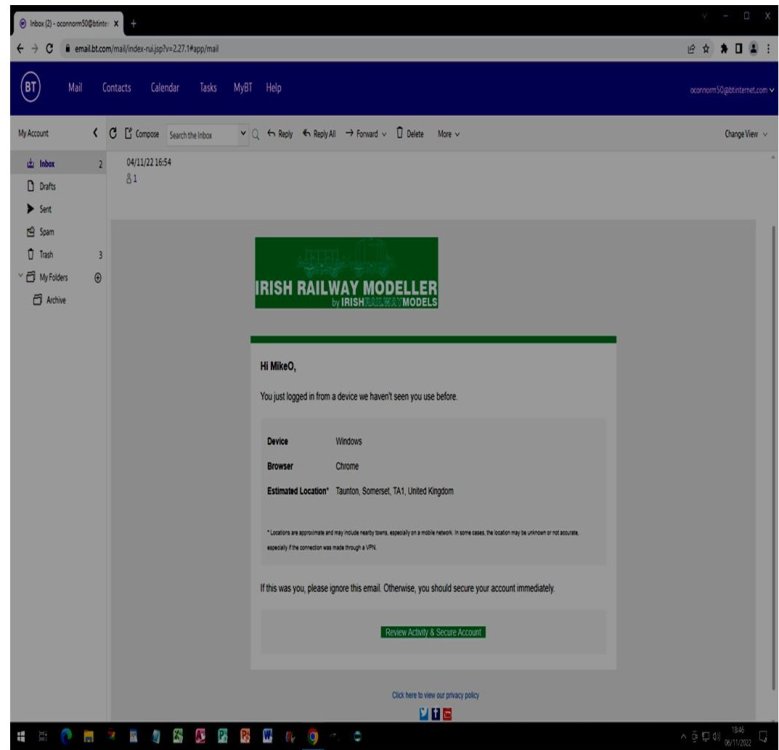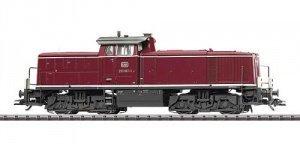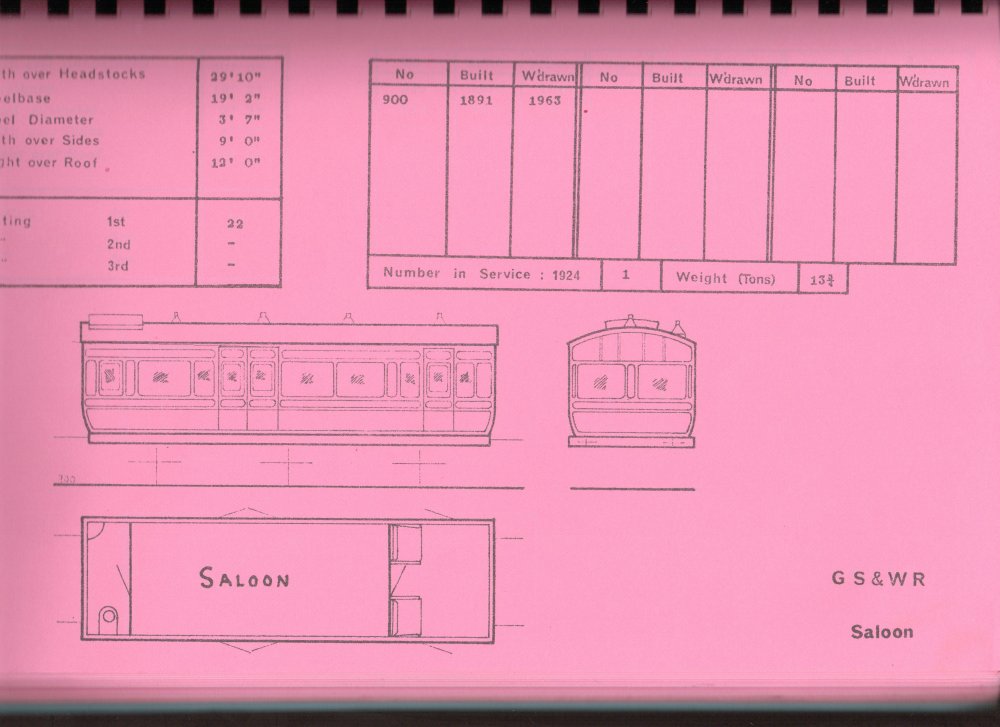
MikeO
Members-
Posts
261 -
Joined
-
Last visited
-
Days Won
1
Content Type
Profiles
Forums
Events
Gallery
Blogs
Store
Community Map
Everything posted by MikeO
-
Thanks BosKonay and mmie353 Did not think of providing a screen shot This is the top of the email and a screen shot of the body of the email. New Device Login Irish Railway Modeller <support@irishrailwaymodels.com> To: MikeO oconnorm50@btinternet.com; 04/11/22 16:54 Its the address that makes me suspicious. I think I will leave the website link as a last resort. Hopefully Admin can confirm or not the authenticity of the email. I would think that there should be a record of its issue on the IRM system if it is genuine MikeO
-
Yesterday I got an email from support@irishrailwaymodels.com saying I had logged in on a new device. The information listed the ne device as Windows, Chrome and an address in England. I did login yesterday but used the same device as I always do. However the address is completely wrong as I do not live in England. Just wondering if this is a genuine email. MikeO
-
Thanks Nick for taking and posting the video of the show. I was pleased to see that our T Trak layout was considered good enough to get included. MikeO
-
I echo the comments above about the standard of workmanship. In addition I though that the sound in the various videos was very life like, the sound of the horn and the noise going over the tracks. just amazing. MikeO
-
Very well weathered. I particularly like the MAERSK. I have an n gauge version which look too pristine. I hope you do not mind if I emulate your scheme. MikeO
-
Ernies Massive Irish 1930's to 2005 Photo Archive
MikeO replied to Glenderg's topic in Photos & Videos of the Prototype
The NCC No 4 in the picture is a U1 class called Glenariff. It was renumbered to 4A in 1947 to make way for the new WT class and with drawn in 1949. Info per Colin Boocock Locomotive Compendium Ireland page 90. -
Ernies Massive Irish 1930's to 2005 Photo Archive
MikeO replied to Glenderg's topic in Photos & Videos of the Prototype
The loco at Thurles may be a J9 possibly no 251. It looks the same as the picture in Colin Boocock's book Locomotive Compendium Ireland page 20. MikeO -
A few photos taken at the 1st Bangor show held on 20/21 May 2022. A general overview of the viewing area. A jeep with a typical UTA( NCC section) train with a 6 wheel brown van at the rear A class 400 in grey at the head of a long line of cattle wagons. Two views of different Class 400 locos at the head of a typical early CIE train with tin van trailing and a cattle train passing. Finally two views of a very impressive new Japanese T trak layout, not mine. MikeO
-
I managed to get a few photos of some of the layouts at the exhibition. i posted my T Trak layout photos on the T trak thread. Four views of Feneghy an OO scale layout of a fictional NCC line set in the Ballymoney area. A closeup of therec NCC liveried 6 wheel coaches Rush hour perhaps? Two new layouts from the Glenabby club First an OO scale layout Second a compact N gauge layout. the stone buildings are Metcalfe card kits Four views of the large Portadown layout. A spectacular layout. How railways started? MikeO
-
A few photos of the T Trak layout at the North Down Show on April 23/24. I only managed to take these 5 photos of the layout. A motely collection of wagons parked in a siding. The modules were not all Irish themed hence a Class 121 with an intercity trains passing a German town. Rule 1 in application. A GNR 4-4-0 with various shades of "Mahogany" passing the same buildings. A Class 800 with a variety of Clerestory and Pullman coaches passing a W H Mills style station and thie historic part of the village. Parked at the back a J15 with a cattle train awaiting its turn of duty. MikeO
-
Thanks Robert, a very helpful reply. I picked these up in Halfords this morning. They are 2mm split pins. As usual I was not in specifically to get them but I thought I would look to see if they had any small split pins. These are the smallest, the largest being 4mm. I will try them on some errant wagons that I have. I like the idea of magnets but have not come across any that are suitable for N gauge models. MikeO
-
Thanks Moxy There are some minor differences between the Farish model and the bus shown in the Flickr photo. Given the small scale it may not be worth adding them in. I suspected that the Atlantean body was different. The yellow one is in Tynemouth livery and the blue in NBC Northern. I should be able to make it straight enough to look similar to a Vanhool or Alexander. MikeO
-
I bought these buses from Marks Models at the North Down show at the weekend. Could any one tell me if the Guy Arab 11 bus ran in Ireland. Also did the Leyland Atlantean buses with the indented rear lower window (as per the yellow bus) run in Ireland. I know that those without the indent did but were likely to be the Leyland Olympian versions. Any help is appreciated. MikeO
-
The use of the split pin for coupling stock is a very good idea. Did you use super glue to attach them to the stock? You mentioned getting smaller pins do you think they might be suitable for N gauge models? If so where did you get them? MikeO
-
The GNR(I) had more than one of this type. In fact 35 although I do not know how many were still in operation. In 1914 there seems to be about 23 still working. No 50 was still operating in 1933 it was photographed at Omagh. The GNR(I) version differs from those of Hattons in several ways. First the planking is all horizontal from roof line to chassis( 9 planks in total) including the doors. Not vertical. Second the running boards did not cover the centre wheels. With regards to markings the No 50 was in the centre of the 2nd plank above the chassis, the letters G N were spaced on either side of the No 50 but on the 3rd and 4th planks, on the 5th plank the words brake van are spaced within the spacing for the letters GN and lastly the 7th plank contained the words 25 Ton just above the words Brake van.. The length was 20ft over body(23ft over buffers) In addition there was a more enclosed version No 95 which contained a drovers compartment with doors roughly in the middle. It was photographed at Antrim in 1955. Markings were different as was the size it was 28ft over body length (31 ft over buffers). Lastly there was a 4 wheel version of the same dimensions as no 50 it was numbered 56. Hope this helps MikeO
-
Hi Mike I am just seeing this today. The loco may be this one If so the following may help. The V 90 series of the Deutsche Bundesbahn (DB) were diesel locomotives with a B'B' wheel arrangement for heavy shunting and shunting work. Externally, the 70 km/h (from V 90 021 80 km/h) fast machines resemble the mainline locomotives of the DB class V 100 . From 1968 they were redesignated as the EDP-compatible 290 series. Series 291 In contrast to the 290, which was equipped with the V12 engine of the 212 series, the 291 series was equipped with an 8-cylinder. colour variants The vehicles were delivered in crimson and were repainted to the new ocean blue and ivory colour scheme from the mid-1970s. The attached link provides more information on the prototype https://de.wikipedia.org/wiki/DB-Baureihe_V_90 Can't find anything on the model itself MikeO
- 1 reply
-
- 1
-

-
The buildings, even without scenery, give a very good impression of the look and feel of a stone built Irish rural station. Sited in an expanse of scenery back and front will really bring it to life. A good backscene can add enormous depth to the scenario. The use stone block work in the original building was such an inspired choice. It really makes a statement. Such a pity the station is long out of use. MikeO
-
Seriously impressive models both for Ballywillan and Belmont House. The scale of the stables really catch the eye. I must give Inkscape a try. MikeO
-
Both your buildings excellent. N gauge is a difficult scale to work in as many features are small and fiddly to make and afix to buildings. I really like the stone work on the Ballywillan station. I watched the tutorial video on the Chandwell link in which Michael demonstrated making a low relief building using Inkscape. While the method was involved there were a lot of good tips that could be used in any model making scenario. MikeO
-
Seagoebox Thanks for that information about coach 900. The double doors on each side would lend its self to use as an ambulance coach. That inturn may mean that it was not rebuilt as a standard 1st class coach until after 1945 perhaps by CIE and then sent to Cork. Would the "two berths" mean that there were beds that could double up as bench seats and the open saloon configuration was kept to the end. Desmond Coakham mentioned it ended its days as the break-down van 465A in Waterford. Again the open configuration would benefit that type of use. JHB Thanks for the livery information. So many potential options.
-
Thanks JHB. I am thinking that the GSWR would have kept the coach in the original W&L configuration/livery and that the GSR, perhaps in the 1930s, would have converted the coach to a more traditional 1st class coach style. Thus changing the interior to conventional seating and changing the livery to crimsion lake. Would that be a plausible scenario? MikeO
-
I was recently looking for information on this coach and came across the thread below dating from 2015. Mention was made that a drawing of Saloon 900 could not be found. I was sent in 2013 a variety of extracts from an IRRS booklet. Included in this was a drawing of Saloon 900. I cannot remember the source. I have attached a copy of that drawing for information. My 2016 set of IRRS Drawings does not show saloon 900. Desmond Coakham in his book Irish Broad Gauge Carriages on page 16 included a photo of Saloon 900 taken at Glanmire Road on 20 June 1953. The coach has been altered a little but is still running as a 1st class coach. The main differences are the removal of one of the double doors and the inclusion of an addition window. The photo shows 7 ventilators along the top of the side I do not know if these were on the 1924 version as the drawing does not show such detail. Does anyone know when the coach was altered and if the ends remained that same as in the original? MikeO
-
Both DiveController, Rob and DJ Dangerous have made a lot of good suggestions. I model Irish and German N Gauge. Changing to N Gauge will involve much more expense. There are lots of RTR British, European and American N Gauge stock, buildings and scenery available. There are no Irish RTR stock you would need to buy other suitable RTR stock and convert them. While N Gauge is roughly half the size of OO the advantage is that you can run longer trains. However you will still have to make compromises as to what you include on your layout in terms of sidings and buildings and where they can be positioned. Even in N Gauge things are still going to be fairly close together. By way of illustration I am including 3 photos of my German layout. This is my second revision which does not fully meets my needs so I will have to expand it again.
-
A great little layout. The weathering technique is very effective and looks simple to achieve.
-
Looks worth a visit late June or early July.
.png.c363cdf5c3fb7955cd92a55eb6dbbae0.png)







